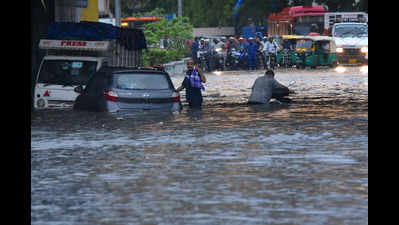- News
- City News
- delhi News
- IMD says Delhi records heaviest June rainfall since 1936
Trending
IMD says Delhi records heaviest June rainfall since 1936
Heavy rainfall in Delhi-NCR caused severe waterlogging and traffic jams, despite official inspections by the CEO of Noida Authority and Delhi Mayor Shelly Oberoi. The downpour disrupted daily life, emphasizing the need for improved infrastructure to handle such weather conditions.

According to the Meteorological Department, Delhi recorded 228 mm of rainfall from 8:30 A.M. on Thursday to 8:30 A.M. on Friday, the highest 24-hour rainfall in June since 1936.
This rainfall brought relief from the intense heat but significantly disrupted daily life.
Delhi usually receives an average of 80.6 mm of rain in June. The recent downpour, however, highlighted deficiencies in the city's infrastructure, particularly the drainage system.
Commuters faced significant challenges with submerged roads and severe traffic jams.
Despite prior assurances from Delhi Mayor Shelly Oberoi, who stated on June 18 that the city was prepared for the monsoon, the rainfall led to substantial waterlogging. Shelly Oberoi had said, "The storm drains were clean and ready, promising a hassle-free monsoon for Delhi residents."
Major intersections such as ITO saw about two to three feet of water accumulation, causing extensive traffic disruptions.
The Hanuman Temple Intersection leading to Mandi House was submerged under three feet of water, leading to road closures and disruptions on Ashoka Road, Feroz Shah Road, and Connaught Place.
Similar conditions were reported in other areas like Moolchand.
In Noida, the situation was equally severe. Inspections conducted by the CEO of Noida Authority and officials on Thursday did little to mitigate the impact of the rain. Many areas, including the Mahamaya Flyover, Sector 62, and Sector 15 and 16, experienced severe waterlogging.
The rainfall lowered the minimum temperature on Friday to 24.7 degrees Celsius, which is 3.2 degrees below normal, providing some relief from the intense heat experienced over the past two months. Nonetheless, the heavy rains served as a reminder of the urgent need for improved monsoon preparedness in Delhi-NCR.
(With inputs from agencies)
End of Article
FOLLOW US ON SOCIAL MEDIA











